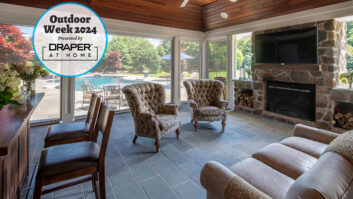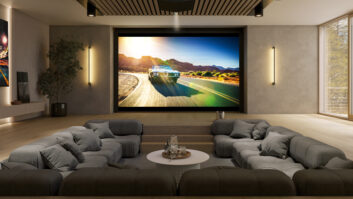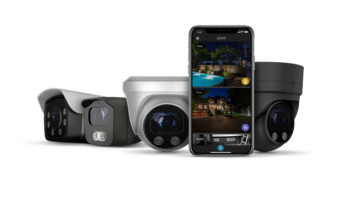One of the biggest challenges facing residential systems professionals today is keeping up with rapid changes in technology from both a knowledge and return-on-investment (ROI) perspective. Currently, display technology is seen as a make or break ROI for installers. At the product level, displays are seen as the driving force in product success, while the sales segment view them as controlling the ship.
In the case of high-definition TV, the consumer is at the helm. A recent Wall Street Journal report on worldwide LCD and plasma sales predicted global sales of approximately 44 million units, with the U.S. accounting for between 12 to 14 million of those sales.
Within the CEDIA market, finding the right balance of product and price could be the difference between a happy client and a possible referral, or a missed opportunity and poor or non-existent ROI. No one wants to compete with the big-box offerings. Background knowledge will help you discuss options with your clients and help future negotiations with vendors.
Most LCD and plasma panels are globally produced by just a handful of firms, with multiple joint partnerships between competing brands producing popular modelsLG and Phillips, Samsung and Sony to name a few. The largest glass maker supplying ultra-pure panels for screen production is American company Corning Glass, which has opened plants next to production facilities in Asia for clients like Samsung, Sharp, and AU Optronics. These joint working relationships allow for JIT or Just-in-Time production, which enables manufacturers to inventory less, keeping monetary exposure with inventory on the shelves to a minimum, and allowing for constantly rotating production lines.
JIT works well in todays global economy but can prevent a wholesale firm from meeting an immediate large demand and subsequently limits an installer from obtaining a specified product to complete a job. In theory, JIT eliminates substantial price drops by preventing closeouts. However, in the case of LCD and plasma units the reality is that prices have dropped by double digits. Manufacturers are trying to counter this trend by building new plants and increasing capacity to meet demand. Sony and Samsung recently announced that they will jointly invest $2 billion on a new LCD plant for eighth-generation display units. Similarly, Panasonics parent company, Matsushita, has completed a new plasma plant in Japan capable of producing five million units per year. With increased worldwide capacity the hope is that prices will stabilize by meeting demand and controlling supply.
The reality is that we expect prices of plasma to drop an additional 15 to 20 percent by the end of 2006, partly due to the increased median size of LCD, and huge investments in plasma technology, thereby increasing yield, confirmed John Taylor, vice president of corporate communications for LG Electronics. This follows an approximate 40-percent drop in LCD and plasma pricing in 2005 from 2004 and subsequently following a 40-percent drop in 2004 from 2003.
With average retail pricing in 2003 over $4,000 and now under $2,000, combined with the increased median size of LCD TVcurrently at 32 inchesincreasing, explosive growth is in the cards. Fourth-quarter results look to be nothing short of spectacular at all levels.
A larger issue facing distributors and integrators is how to make up for lost profits due to any shortages or price drops. Manufacturers are finding several ways to avert profit losses. Flat-panel pricing is dropping, but the market is now transitioning from lower priced, CRT-based RPTV, to more expensive fixed-pixel displays, said Scott Ramirez of Toshiba. This change, along with increased volume, helps mitigate the negative effects of price erosion in the TV category.
Pioneer Electronics vice president of display products, Paul Meyhoefer, said that the company has maintained dealer margins, thereby making up for any difference in total profit as sales volume increases, while BenQs Mitch Rauch said that profit from an investment standpoint only suffers at the entry level, where prices are being driven down.
How can suppliers and integrators take advantage of these trends and avoid JIT production pitfalls while increasing ROI? A striking example of how this can be done comes from LCD and plasma manufacturer, Sampo Professional. Essentially an unknown brand to the big-box houses, Sampos pricing is regulated to prevent big swings. It is not a commodity box and is therefore perfect for application-based installations, especially with standard features like ethernet control across the product line. For installers, this allows full monitoring and control via IP-addressable networked computers.
As to what kind of display is best for home theaters, manufacturer opinion is based on application. For static displays LCD is often the best choice, while optimal video-based viewing can be had via plasma. But Toshibas Ramirez points to the ultimate arbiter of choice. I think most consumers are technology agnostic, Ramirez said. Consumers want flat-panel TV. I think they will compare brand equity, picture quality, cosmetic design, and price point. Based on these factors, they will choose a model that may turn out to be LCD or plasma.
Plasma currently has a price advantage, Ramirez continued. But as LCD panel pricing continues to fall, we will eventually see price parity. Then, the market will decide the mix, but I think LCD will come out on top.
Installers and distributors have to continually educate themselves on these trends before attempting to make a sale. LG has what some installers could perceive as an advantage with separate product lines for installers, offering model numbers not found at the big-box outlets. With LCD offerings ranging from 32 to 55 inches and a new lineup rolling out through the third quarter of 2006, an installer has plenty of choices.
LGs model 47LB1DRA 47-inch LCD, which has a built-in HD DVR and two ATSC tuners, is sold only through specialty retailers. The company is also rolling out new plasma products, including the 60-inch 60PB2DR, which will be available this August. It also comes equipped with dual HDMI inputs and a DVR for storage of up to 15 hours of digital hi-def content.
A firm synonymous with plasma displays is Pioneer Electronics whose advanced research and development in the field has allowed for the first rollout of a 50-inch 1080p unit, the PRO-FHDI. With an estimated retail price of $10,000, the PRO-FHD1 display will up-convert all sources for HD image, theoretically improving image detail, color accuracy, and moving image clarity. The Elite PureVision PRO-FHD1 is specifically targeted to the high-end enthusiasts seeking a premier display, Meyhoefer said. For consumers who are shopping at a Best Buy or Circuit City, specifications arent a deciding factor when it comes to purchasing.
If your client wants a really big image of over 84 inches, then a projector is the way to go, but if your client wants the simplicity of a traditional television, can afford the price tag, and has the real estate to hang or place a panel, then plasma or LCD is still the answer. Even as prices erode, and distribution lines become blurry, there are still a few exclusive flat-panel video options remaining for the custom installation and specialty retail channels. At least for now.
With 25 years of audio and video industry experience, Wayne Dolnick ([email protected]) is a freelance writer as well as a consultant to the AES and CES trade shows.







